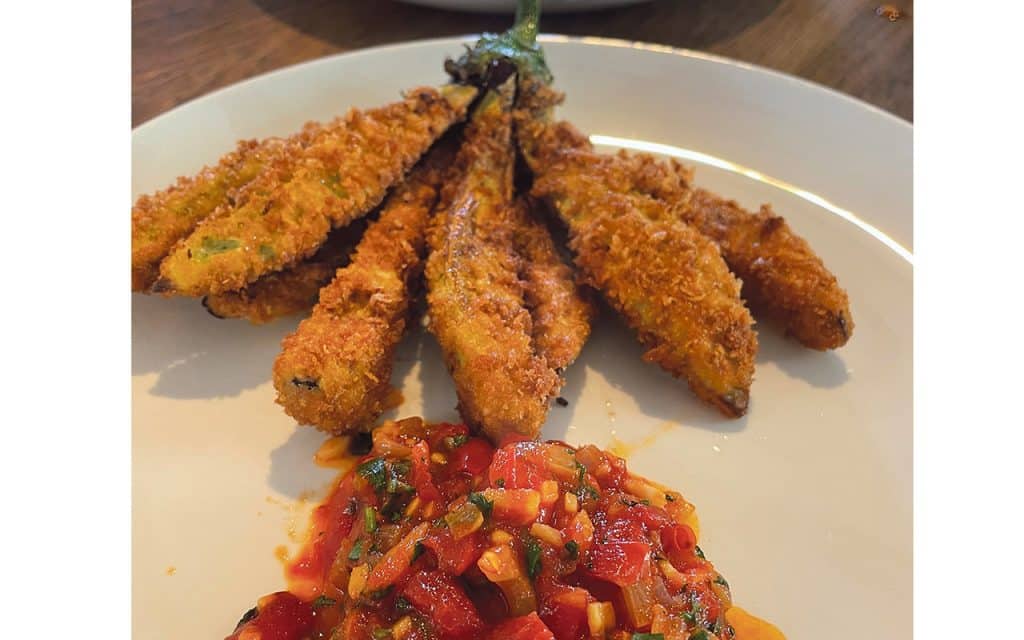We have a fantastic aubergine colony with very productive slim fruits growing in our tunnel. We grow a variety called ‘long purple’, which are obviously happy where they are, as we pick from July through to the end of October and each week we harvest two or three aubergines from each plant. We have eight plants, which I couldn’t resist growing ‘just in case one or two failed’ so we have plenty!
An aubergine is another vegetable that is biologically a fruit from the nightshade family – a berry to be precise. These beautiful deep purple – we’ll call them vegetables – are also known as eggplants. They come in many different shapes, sizes and can be various colours. From deep purple, almost black, to stripy magenta or white – which must be where the name eggplant comes from. They are beautiful and beguiling. Aubergines are grown pretty much anywhere in the world where there’s some sunshine, Africa, Asia, Middle East, Mediterranean, India, China, Australia… you name it , they grow there.
The most common aubergine to be found in the supermarkets here is the large purple variety, although during the summer, smaller and more varied varieties are often available in the farmers’ markets, wholefood shops and delis, which are supplied by local growers.
A badly cooked aubergine can put people off them for life but, cooked well, they are delicious. They are also fat-free (unless you bathe them in oil), low in calories and high in fibre. They can be roasted, fried, grilled or baked but do not boil them.
I find the best way to cook an aubergine, unless I’m roasting it over a flame or on the grill, is to salt it first. It sounds like a bit of a faff but is actually fast and simple and it makes a difference to the amount of oil the aubergine will absorb while cooking.
Aubergines do need to be cooked, it’s not a vegetable to eat raw and, when cooked correctly, the flesh yields a wonderful toothsome creaminess, delicious combined with all sorts – just look at where they are grown and you can imagine the spectrum of flavours that all the different recipes can supply.

This month’s recipe is for a fun aubergine ‘octopus’ and everyone I have cooked it for has been delighted. I cut the aubergines into strips to the stem, salt them, then dry them off, enrobe them in panko breadcrumbs then deep fry them. The strips splay like an octopus while cooking and the aubergine is perfectly cooked within the crisp golden panko crust. It is not difficult to make, just salt the aubergines, organise yourself with three bowls for dipping and you’re nearly there. They are good served with sauce to dip. I serve them with tomato and ginger salsa but if you’ve run out of steam a good mayonnaise could substitute.
Buy small aubergines if possible, there’s no problem using large aubergines but a large aubergine makes a very big octopus!
Aubergine Octopus
Serve one per person
• 2-4 small aubergines
• 100-150g flour
• 2-3 eggs
• 100-150g panko breadcrumbs
• Vegetable oil to deep fry
Peel the aubergines. Do not remove the stem. If they are big, cut in half lengthwise.
Cut each aubergine into three lengthwise, up to the stem but not through. Turn the aubergine and cut three times once more – you will have nine tentacle-shaped pieces. Hold each aubergine over a bowl then sprinkle with salt. Leave the aubergines to sweat for 10 minutes.
Take a clean tea-towel, lay the aubergines down then pat dry.
Crack the eggs into a bowl then whisk to mix.
Put half of the flour into a shallow bowl/plate and half the panko breadcrumbs into a shallow bowl or plate. The bowl/plate needs to be as wide as the aubergines.
Put the bowls in a row – flour/egg-mix/panko, in that order (or reverse if you are left-handed).
Take a dried aubergine and dredge through the flour, sprinkle a little over to ensure each ‘tentacle’ is coated. Tap to remove excess flour. Repeat with remaining aubergine. Next drag an aubergine through the egg mix until well covered then hold up and allow excess to drip off then roll the aubergine through the panko, scattering a little over the top until the aubergine is well coated.
Heat the vegetable oil in a wok/large old pan/deep-fryer. There must be sufficient oil to submerge the aubergine.
Check the oil is hot enough – I usually use a piece of bread or similar, if it pops back to the surface the oil is ready. If sinks to the bottom it’s not hot enough, if the piece just pops back to the surface it’s ready and if it nearly leaps out reduce the heat.
Take an aubergine by the stem and slip into the oil, it will fan out. Cook each side until golden, turning to cook each side with the assistance of a large lifter or maybe two. Drain on kitchen paper and repeat the process with the remaining aubergine.
Tomato and Ginger Salsa
• 1 small onion
• 2 cloves garlic
• 4cms ginger
• 1-2tbs vegetable oil
• 2-4 large ripe tomatoes or
1 can
• salt
• Fresh coriander to serve
Peel and finely chop the onion and garlic. Peel and chop the ginger very small. Dice the tomatoes.
Heat a small frying pan, add a tablespoon of oil and the onion. Cook on a medium heat until the onion has softened, 4-5 minutes. Stir in the garlic and chopped ginger and continue to cook until they have also softened, 3-4 minutes. Add the diced tomato and season with a little salt. Cook on a medium/low heat until the tomato has reduced and become jammy. Check the seasoning.
Enjoy!
Lettercollum Kitchen Project,
Timoleague
info@lettercollum.ie
www.lettercollum.ie



